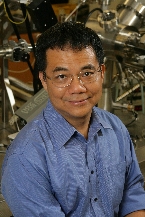
Abstract
Organic photovoltaics (OPV), solar cells based on carbon-based semiconductor materials, are a potential low cost alternative to conventional inorganic semiconductor photovoltaics. They enable the production of lightweight, flexible, and even semitransparent and light polarizing solar panels. This could open up applications that are not practical with inorganic cells. Examples include power producing LCD displays or tinted windows and ultralight large area flexible panels for field or space applications. The fundamentals of OPV will be discussed in this talk as well as our current work in the field. One type of organic photovoltaic device is the polymer-fullerene bulk heterojuction (BHJ) cell that our group focuses on. A BHJ is a nanoscale phase separated blend of a semiconducting polymer and a buckminsterfullerene (C60) derivative. This design allows for efficient separation of the tightly bound electron hole pairs (excitons) that form in illuminated organic semiconductors. The structure of the bulk heterojunction has a large effect on performance and controlling this morphology is critical to fabricating high performance devices. One strategy to achieve higher performance devices is to combine two cells with complementary spectral absorption ranges into a vertically stacked, serially connected “tandem” device. Having materials with two different bandgaps allows more of the energy of the high-energy photons to be recovered, which would otherwise be wasted if a single low bandgap material absorbed them. This approach can lead to higher efficiency than is possible with a single cell. Our recent work has verified the expected advantages of stacked over single layer devices, and an NREL certified 8.6% device will be reported in my presentation.
Biography
Yang Yang holds a BS in Physics from the National Cheng-Kung University in Taiwan in 1982, and he received his M.S. and Ph.D. in Physics and Applied Physics from the University of Massachusetts, Lowell in 1988 and 1992, respectively. Before he joined UCLA in 1997, he served on the reseasrch staff of UNIAX (now DuPont Display) in Santa Barbara from 1992 to 1996. Yang is now the Carol and Lawrence E. Tannas Jr. Endowed Chair Professor of Materials Science and Engineering at UCLA. He is a materials physicist with expertise in the fields of organic electronics, organic/inorganic interface engineering, and the development and fabrication of related devices, such as photovoltaic cells, LEDs, and memory devices. His notable contributions to the field of organic photovoltaics are an enhanced understanding of polymer morphology and its influence on device performance; the invention of the inverted organic solar cell, the inverted tandem solar cell, and photovoltaic polarizers for LCD applications. Together with Solarmer Energy Inc. (spun-off from UCLA) and Prof. Luping Yu at the University of Chicago, he has taken part in the creation of several world record cells in organic photovoltaics. In addition to organic solar cells, his group is also heavily involved in the development of liquid-processable CIGS/CZTS photovoltaics. His group has achieved approximately 11.2% PCE using a CISS absorber layer deposited from a solution- phase precursor system. Yang has received the following honors/awards: The Carol and Lawrence E. Tannas Jr. Endowed Chair in Engineering, July 2011; Top 11 Hot-Researchers in 2010, Science Watch (published by Thomas Reuters); Highest cited Paper in 2010, Advanced Functional Materials; Highest cited Paper in 2008-2010, Journal of American Chemical Society (JACS); IEEE Photovoltaic Field Expert, 2009; Microelectronics Advanced Research Corporation Inventor Recognition Award, 2007; NSF Career Award, 1998; 3M Young Investigator Award, 1998. He has published more than 240 peer-reviewed papers (including book chapters); 40 patents (filed or issued), and given 120 invited talks. His H-Index is 66 as of September 2011.